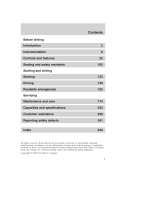
• A/C-Uses outside air to cool the vehicle. It is
quieter than MAX A/C but not as economical.
Airflow will be from the instrument panel
registers.
• VENT-Distributes outside air through the
instrument panel registers. However, the air will
not be cooled below the outside temperature
because the air conditioning does not operate in
this mode.
• OFF-Outside air is shut out and the fan will not
operate. For short periods of time only, use this
mode to prevent undesirable odors from entering
the vehicle.
•
(Panel and floor)-Distributes outside air
through the instrument panel registers and the
floor ducts. Heating and air conditioning
capabilities are provided in this mode. For added
customer comfort, when the temperature control
knob is anywhere in between the full hot and full
cold positions, the air distributed through the
floor ducts will be slightly warmer than the air
sent to the instrument panel registers.
•
(Floor)-Allows for maximum heating by
distributing outside air through the floor ducts.
However, the air will not be cooled below the
outside temperature because the air conditioning
does not operate in this mode.
•
(Floor and defrost)-Distributes outside air
through the windshield defroster ducts and the
floor ducts. Heating and air conditioning
capabilities are provided in this mode. For added
customer comfort, when the temperature control
knob is anywhere in between the full hot and full
cold positions, the air distributed through the
floor ducts will be slightly warmer than the air
sent to the instrument panel registers. If the
temperature is about 10°C (50°F) or higher, the
air conditioner will automatically dehumidify the
air to prevent fogging.
Controls and features
20





















